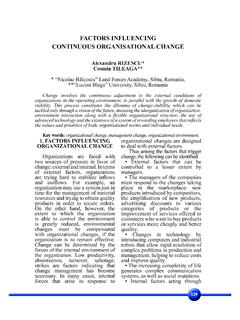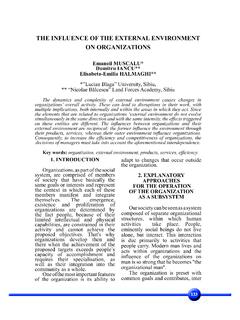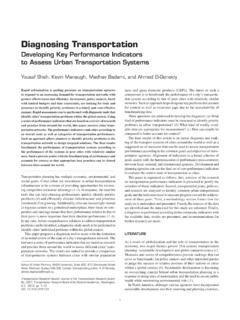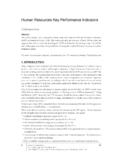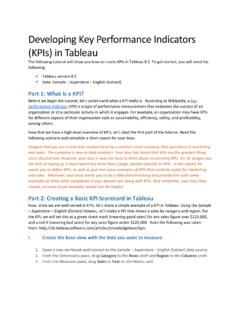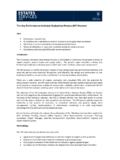Transcription of CHALLENGES WHEN DEVELOPING PERFORMANCE …
1 CHALLENGES when DEVELOPING PERFORMANCE INDICATORSB rindusa Maria POPAR egional Department of Defense Resources Management Studies, Brasov, RomaniaDeveloping key PERFORMANCE indicators (KPIs) represents one step closer to the achievement of objectives and strategic vision of the organization. They are important elements of the pathway towards PERFORMANCE , they evaluate and indicate the level of progress, guide the organizational strategy, they can be considered even the qualitative or quantitative expression of the execution of the strategy.
2 Building reliable and appropiate measurement systems is one of the most diffi cult stage in the PERFORMANCE evaluation process. Such systems of management will help the executives and the management teams identify and build upon the elements that create competitive advantage and opportunities for better words: KPI, KPQ, measurements, culture, strategies, goals, ORGANIZATIONAL STRATEGY AND PERFORMANCEN owadays, the trend in societies and in economies is a constant growth in complexity and volatility.
3 Organizations, as part of the social and economic environment, are infl uenced by these phenomena thus, establishing accountability and strategy has became a crucial, but very sensitive matter for managers. With the purpose to respond as accurateley as possible to all these changes, measurement systems have been developed in order to evaluate organizational reliable and appropiate measurement systems is one of the most diffi cult stage in the evaluation process. Such systems of management will help the management teams identify and build upon the elements that create competitive advantage and opportunities for better of the buzz terms of the decade is KPI (Key PERFORMANCE indicator ).
4 Everyone agrees on the importance of KPIs since they are closely linked to the accomplishment of objectives and of the organizational strategic vision. They are important elements of the pathway towards successful achievent of objectives, they evaluate and indicate the level of progress, guide the organizational strategy, they can be considered even the qualitative or quantitative expression of the execution of the to Dennis Mortensen A KPI: 1) Echoes organisational goals, 2) is decided by management, 3) provides context, 4) creates meaning on all levels of the organization, 5) is based on legitimate data, 6) is easy to understand and 7) leads to action.
5 [1] Despite their important role, we should be very careful when establishing and using KPIs. One of the most frequent problems arises from the overusage of such indicators, meaning that, not everything should be measured. According to specialized literature (some say Peter Druker, others say Edward Deming), what gets measured, gets done . This is true, but should everything be measured? We should measure only what helps us make better informed decisions in order to diminish uncertainty and to clarify the direction to be taken.
6 We should measure only the things that can tell what is most important in and for the organization. Therefore, establishing the right indicators is not simple. A KPI is a metric, but a metric is not always a KPI. However, if the metric can be used as source for recommendations that could impact positively present or future ways of action, it can be a KPQs AND THE DESIGNING OF KPIs Organizations should not only try to capitalize on their strengths, but they should also attempt to discover their weaknesses and try to minimize them.
7 Finding out what the organization cannot do or what it is not good at is not proof of ignorance, it is actually a step towards improving the activity. The simplest way to design a KPI is by asking a question, a question that will elicit an answer about what is needed to be known, about the data that is necessary to be collected in order to assess progress. Such questions are called Key PERFORMANCE Questions (KPQs).KPIs should always be correlated with KPQs in order to show more clearly why the data collected is relevant.
8 Collecting data just because it is interesting to know and not making use of it in the decision taking process is just a waste of time and resources. KPQs must be derived from the organizational strategy, each strategic objective can be the source of one or more KPQs. For example, if the objective of your organization is to increase profi t, the number of people accessing the company s website is just a metric, unless it impacts or can be correlated with the guide us towards what we need to know, data collected randomly, generally, is not useful information.
9 KPQs should not be generic, standard questions from already existing questionnaires, they should always be tailored to the specifi c domain and the stage of activity. One of the most diffi cult questions is what could be be measured in the organization in order to show what progress has been deciding upon one KPI we should start by considering the main (fi nal) objective(s) to be attained, then breaking it into sub-objectives and only then trying to develop the KPI.
10 Unfortunatelly, the ICE approch (described below) appears far too often when DEVELOPING KPIs [2]:1. Identifying the elements which are easily measurable; 2. Collecting data about easy to count elements;Figure 1. The ICE approach3. Ending up with a lot of irrelevant , the information provided by the KPIs is wrong or in the best case, partially relevant. KPIs should not be developped in excess, not every activity needs measuring since not every measurement brings useful information on the progress should be four main reasons for DEVELOPING KPIs:- to check if the ways of action adopted are in acoordance with the objectives;- to gather the information necessary to improve the activity;- to control and monitor the activities and the people performing them;- to provide support for the reports going to external stakeholders (external reporting indicators).



